My efforts to escape COVID-19 and maintain social distancing have led me out of Boston and back to my parents’ rural home in Western Connecticut. There are 7 of us in the house now: my parents, my 3 siblings, myself, and my boyfriend. We’re busy working, studying, and getting creative about how to best quarantine two of my recently-arrived siblings for 14 days in the ever-shrinking space diminished by our ever-growing household. Privacy is scarce, noise is abundant, and I’m constantly bouncing from the bedroom to the office (to the kitchen to another bedroom) to take calls.
After spending more time in a full house than I could remember, I became curious to learn how others were navigating their experiences. We’ve been using our homes more than ever and, in turn, needing more from them to accommodate us and our altered lifestyles. How are people managing the physical and social aspects of living in spaces that aren’t designed for social distancing? What adaptations have they made to accommodate new people, new functions, and new routines?
With my design research and usability background, I turned to the Essential team and encouraged them to share photos and stories of their unique home environments. What I uncovered was a collection of interesting advice, affordances, and aspirations that, together with inspiration from other explorations of space (linked below), I synthesized into 4 key principles: Embrace Tiny House Principles, Bring the Outdoors In, Use Visual Cues to Prompt Behavior Changes, and Create Barriers.
I hope these 4 principles provide useful ideas on how to make the most of your own space and home.
1. Embrace ‘Tiny House’ Principles
Seeking to create a sense of multiple ‘places’ in the same room, one colleague was inspired by the way tiny houses have built-in ways of transforming spaces. Tiny house owners and designers have found ways to fit a kitchen, bedroom, living room, and other living spaces into uniquely small homes by embracing multi-functionality. The kitchen table turns into an extra bed, the desk folds out from the wall, and the home is full of creative storage solutions. My coworker wondered how we can apply similar principles to transform more traditional homes.
Some of our designers and engineers made their spaces more multi-functional by bringing home 3D printers to put on their bureaus or converting their desks to work for both online and hands-on maker work. One of our engineers is still perfecting his desk transition from “computer” to “messy mechanic”.
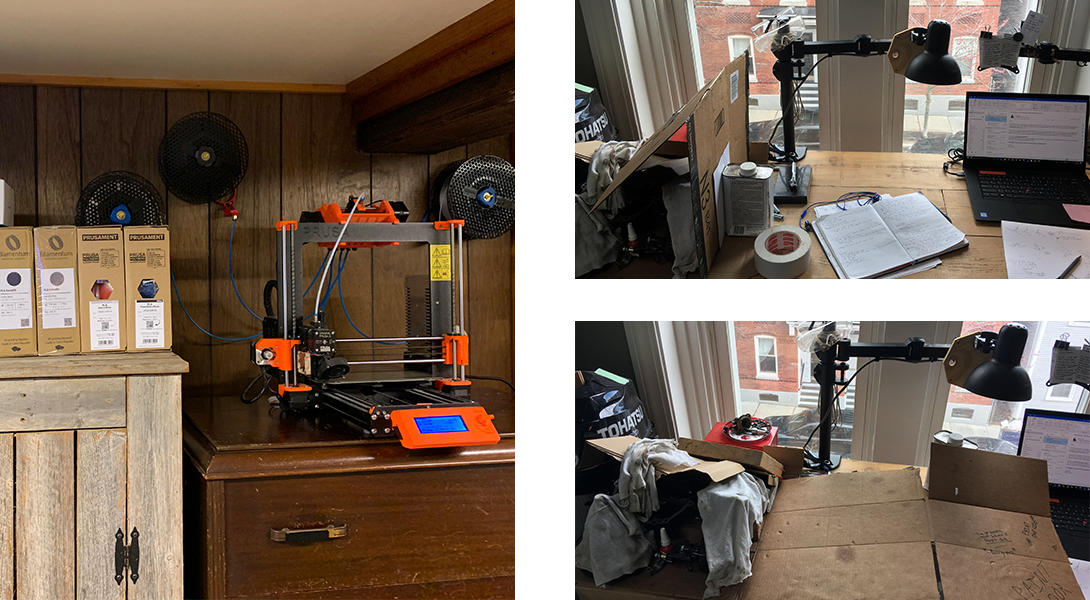
A 3D printer brought home to a bureau and a desk as it transitions from “computer mode” to “messy mechanic”.
Another lesson we can take from tiny houses: don’t be afraid to use all of your space! One of my coworkers described how she has work set-ups in multiple rooms, as she needs to be mobile to accommodate her husband and son who are also using the open spaces in her home. In just the past few weeks, she’s worked in her dining room, bedroom, kitchen, and living room, and has even taken a conference call from a small mud room!
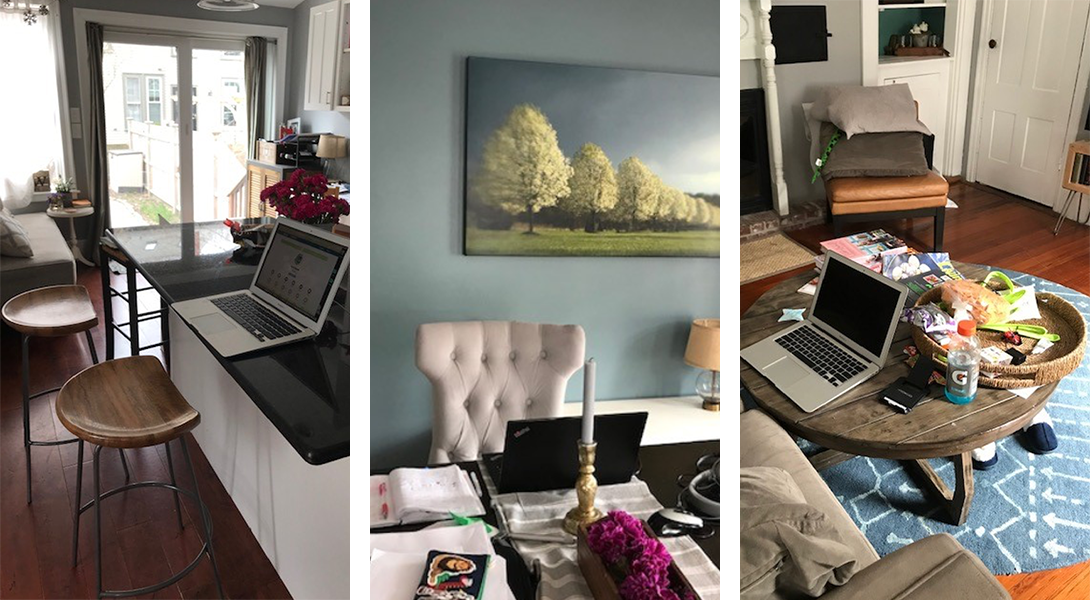
One of my coworker’s multiple work set-ups, featuring her kitchen, dining room, and living room.
2. Bring the Outdoors In
This experience has emphasized another coworker's need for open, light spaces. Features like high ceilings, natural light, big windows, or greenery, can be worth their weight in gold. She felt that the extent to which we can connect to nature within our homes and indoor spaces can improve our spirits during both work and non-work hours. And for people who might live in what feel like actual tiny homes, there are ways to accomplish this even without the affordances of larger spaces. It can be as simple as getting a house plant, keeping a window open for a spring breeze, or taking an extra minute to open the shades all the way. One coworker has been able to bring more “sun”light inside with a light box, a lamp intended to simulate the sunlight.
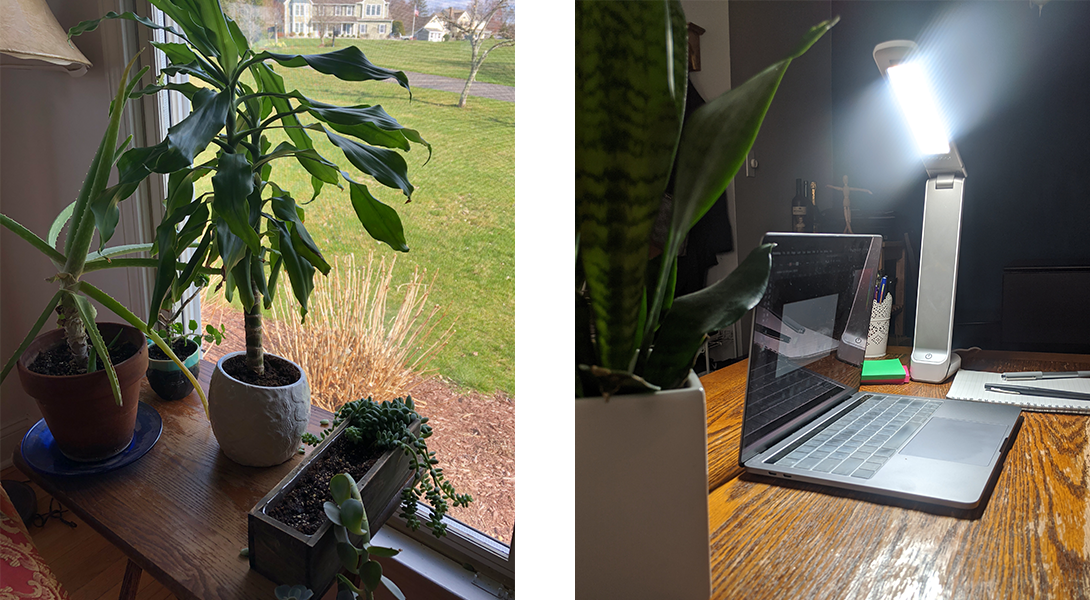
A plant collection that my sister keeps near her workstation and my coworker’s SAD sun lamp.
Of course, there are some benefits of the outdoors that can’t be replicated inside. For anyone else enforcing in-home separations, one colleague aptly noted how much more comfortable it is to be 6 feet away from people outside compared to inside. While it feels very impersonal to be sitting in a living room 6 feet apart, it can feel much more natural to be outside on a walk or a bike ride. This has been an effective technique for my own family, as it’s been a strain (both spatially and emotionally) to keep distance within the house from my quarantined siblings. A spread-out walk around the block feels much more natural.
3. Use Visual Cues to Prompt Behavior Changes
Necessary precautions for staying safe are encouraging people to adopt new behaviors and practices, including more stringent cleaning habits. Visual cues in our homes can support this newfound imperative to clean to higher standards. One team member has designated a visible space to leave shoes and has strategically placed cleaning sprays and wipes near doorknobs as effective nudges to help keep clean. In the same vein, perhaps families could openly post “chore chart competitions” on their fridges to encourage competition and reinforce new cleaning habits.
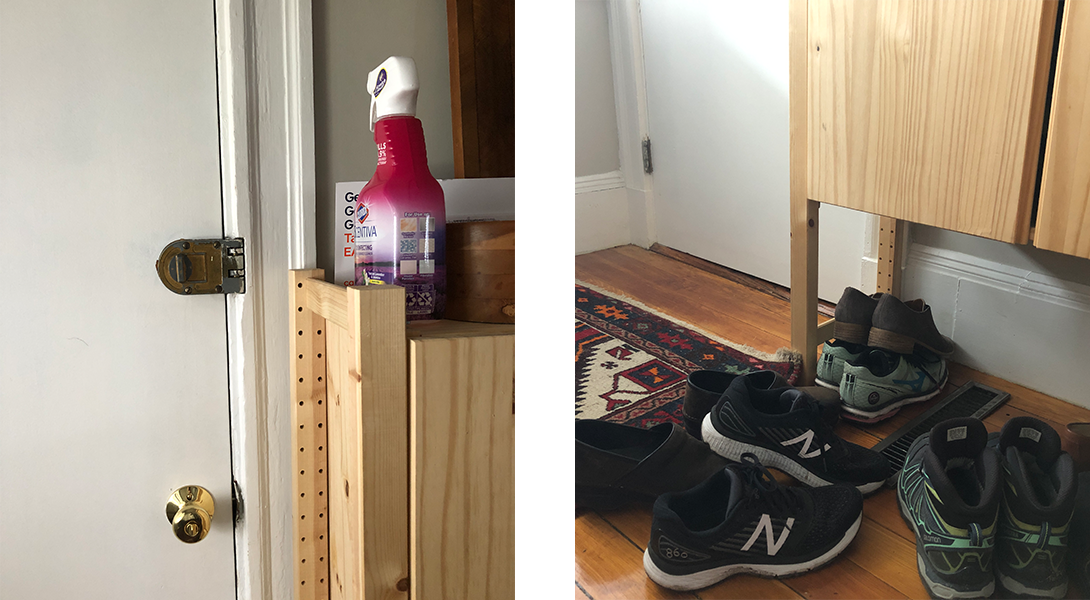
Pictures of a coworker’s visual nudges to promote cleanliness: cleaning solution placed near the door (left) and a designated shoe area (right).
One of my coworkers is using cute artwork to encourage frequent handwashing in her apartment among her roommates. It’s easier to remember to wash your hands as soon as you come inside if you read about it on the front door! Another coworker uses a window near her desk as a whiteboard to display when her and her husband are planning calls in their shared office space. This helps them work around each other’s schedules without having to ask each other about it each time a call comes up.
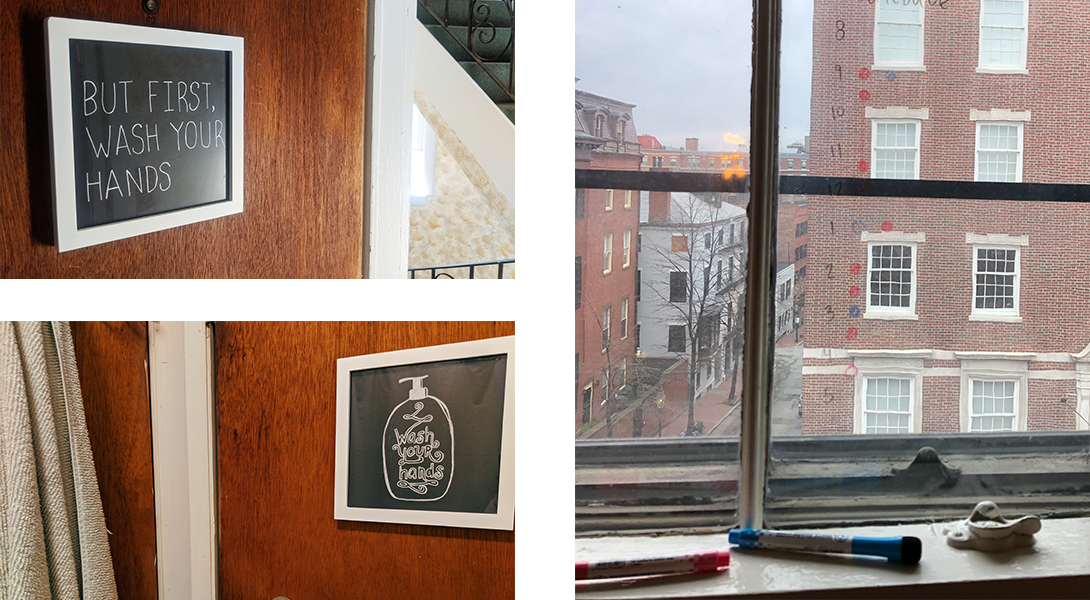
Visual reminders including decorative hand-washing prints and a window-whiteboard to help my coworker and her husband plan around each other’s call schedules in their shared office space.
My family also enlisted visual reminders to help us enforce the quarantine of my recently-arrived siblings. Posters with pictures of faces were put at the entry of specific bathrooms and living spaces, noting who is allowed to use the room. It’s certainly weird to see posters up around the house instructing where you can and cannot go (think “Please only use this bathroom if you are: Annie, Luke, Elise”, accompanied by fun headshots.) But it is also an effective way for us to remember to change movement patterns in a space that historically had no restrictions – and it’s been working so far.
4. Create Barriers
With more of us at home, more often, we also have to find new ways of creating distinct spaces, whether to contain potential illness or to get the privacy and quiet that we need. Adding divisions, re-imagining the use of existing boundaries, or blending indoor and outdoor spaces are a few ways in which these barriers can be achieved.
One coworker suggested that if someone they live with were to get sick, they would need to add doors in their home to make private spaces and keep the virus contained. Because door installation may not be feasible, adding make-shift doors with heavy noise-absorbing blankets between previously open spaces could be a way to create more distinct spaces. Beyond separation for safety purposes, this would also be a useful strategy in creating more private living spaces for work or personal needs.
Another member of my team spoke about a recent visit to her parents’ home, during which she and her husband spoke to them from their porch, safely through the glass window of their back door. They also planned another visit for a cocktail hour in that setup once the warmer weather came!
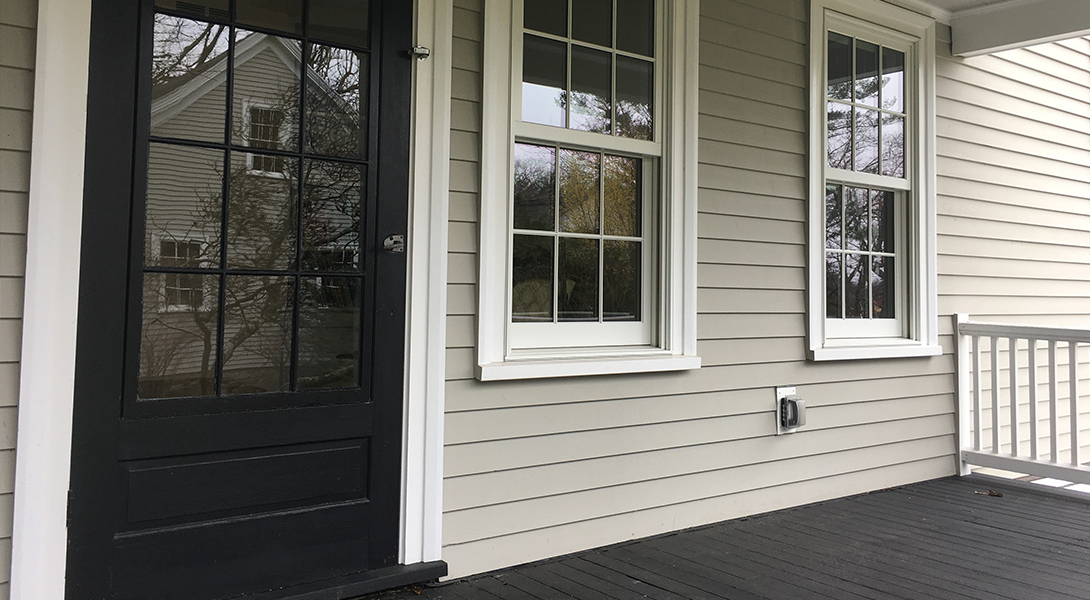
A glass door used to safely communicate from inside the house to the porch.
If you are in a position to separate yourself from others in the house, who says you can’t set up a video chat between different rooms? Online tools that help you sync-up Netflix on multiple devices can also be used without being too far apart! Physical barriers don’t have to become social barriers, as evidenced by my coworker’s porch cocktail hour.
Looking Forward
The demands on our homes are greater than they have been ever before. As we all reflect on the meaning of home, I’m reminded that home is much more than the physical space – it's the social dimension within the four walls. I’m capitalizing on this duality by nurturing connections with those who are important to me, both inside the home and out.
The power of human interaction can help our homes deliver on their long-standing promise to make us feel comfortable and comforted. We can turn this time dominated by uncertainty and fear into one that also boasts new-found levels of care and compassion. Let’s challenge ourselves to make each other feel as at-home as ever. I have a feeling “home” will be able to rise to the occasion.
Please Note: It’s important to acknowledge the immense suffering felt by the many sick, struggling, or otherwise directly impacted individuals in this crisis. I recognize that home experiences discussed here are not complete portraits of what individuals or families may be going through during this time.
For more insight on this topic, check out these related reads:
- 15 Architects and Designers on How the Pandemic Will Change Our Homes Forever | Dwell
- Design in the age of pandemics | Curbed
- What role do planning and design play in a pandemic? Ann Forsyth reflects on COVID-19’s impact on the future of urban life | Harvard GSD
- Social Distancing Is Impossible When You Can’t Afford To Live Alone | The Bold Italic
- Coronavirus Risk Doesn’t Stop At Your Front Door | The Atlantic
__________
Annie Beier is a Design Researcher on Essential's Innovation Strategy team.
Essential Design is a leading Innovation Strategy & Design consultancy. We work across the healthcare, consumer, and commercial industries, helping our clients conceive and drive to market comprehensive digital, physical, and service experiences.


